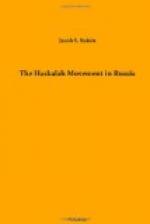Soon the Russo-Polish Jews established at home what they had been compelled to seek abroad. Hearing of the advantages offered in the great North-East, German Jews flocked thither in such numbers as to dominate and absorb the original Russians and Poles. A new element asserted itself. Names like Ashkenazi, Heilperin, Hurwitz, Landau, Luria, Margolis, Schapiro, Weil, Zarfati, etc., variously spelled, took the place, through intermarriage and by adoption, of the ancient Slavonic nomenclature. The language, manners, modes of thought, and, to a certain extent, even the physiognomy of the earlier settlers, underwent a more or less radical change. In some provinces the conflict lasted longer than in others. To this day not a few Russian Jews would seem to be of Slavonic rather than Semitic extraction. As late as the sixteenth century there was still a demand in certain places for a Russian translation of the Hebrew Book of Common Prayer, and in 1635 Rabbi Meir Ashkenazi, who came from Frankfort-on-the-Main to study in Lublin, and was retained as rabbi in Mohilev-on-the-Dnieper, had cause to exclaim, “Would to God that our coreligionists all spoke the same language—German."[19] Even Maimon, in the latter half of the eighteenth century, mentions one, by no means an exception, who did not “understand the Jewish language, and made use, therefore, of the Russian."[20] But by the middle of the seventeenth century the amalgamation was almost complete. It resulted in a product entirely new. As the invasion of England by the Normans produced the Anglo-Saxon, so the inundation of Russia by the Germans produced the Slav-Teuton. This is the clue to the study of the Haskalah, as will appear from what follows.
Russo-Poland gradually became the cynosure of the Talmudic world, the “Aksanye shel Torah,” the asylum of the Law, whence “enlargement and deliverance” arose for the traditions which the Jews carried with them, through fire and water, during the dreary centuries of their dispersion. It became to Jews what Athens was to ancient Greece, Rome to medieval Christendom, New England to our early colonies. With the invention and importation of the printing-press, the publication and acquisition




